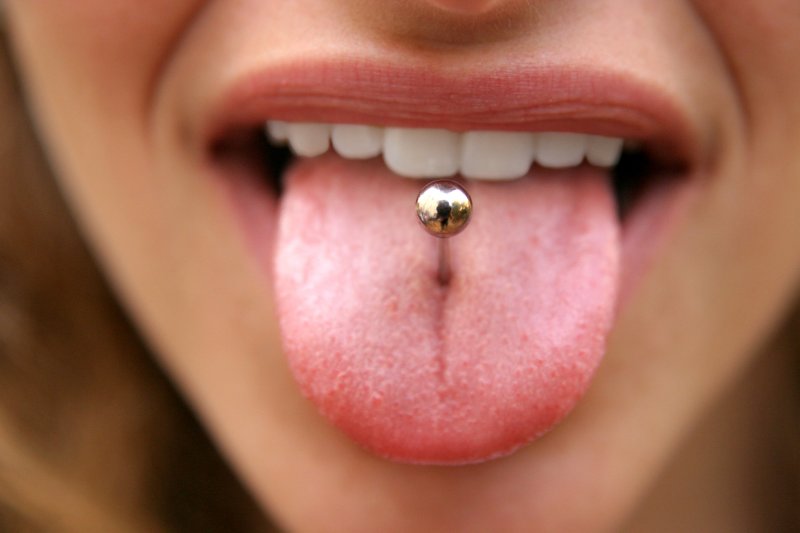The Cultural and Historical Significance of Tongue Piercings: A Professional Analysis
The practice of tongue piercing, while often perceived as a contemporary form of body modification, carries profound historical and cultural significance that extends far beyond modern aesthetic considerations. This comprehensive examination explores the multifaceted meanings behind tongue piercings, from their ancient spiritual origins to their contemporary role in personal expression and identity formation.

Understanding the Modern Phenomenon
In today’s society, tongue piercings have become increasingly common, particularly among younger demographics seeking unique forms of self-expression. However, the motivations behind this choice remain largely misunderstood by the general public. While some view it as a simple fashion statement or rebellion against conventional norms, the reality encompasses a complex interplay of cultural, psychological, and personal factors that merit deeper investigation.

The prevalence of tongue piercings in modern culture has sparked curiosity about their underlying significance. This seemingly straightforward body modification carries layers of meaning that vary dramatically across different contexts, cultures, and individual experiences. Understanding these various dimensions provides valuable insight into both historical practices and contemporary social dynamics.
Historical and Spiritual Foundations
Ancient Mesoamerican Traditions
The practice of tongue piercing possesses remarkable historical depth, with documented evidence of its use in ancient Mesoamerican civilizations. Among the Maya and Aztec cultures, tongue piercing held profound spiritual significance that transcended mere aesthetic considerations. These ancient peoples incorporated tongue piercing into their most sacred religious ceremonies, where it served as a critical component of spiritual communication and divine connection.
In these traditional contexts, priests and spiritual leaders would pierce their tongues during ceremonial rituals, believing that the act created a direct pathway for communication with deities. The bloodletting associated with this practice was considered a sacred offering, representing the ultimate sacrifice of one’s physical being to establish spiritual connection. This ritualistic approach to tongue piercing demonstrates how the practice served as a bridge between the earthly and divine realms.
Sacred Symbolism and Spiritual Transformation
The spiritual dimensions of ancient tongue piercing practices extended beyond simple communication with deities. The act itself was viewed as a form of spiritual transformation, where practitioners underwent a profound change in their relationship with the divine. The temporary pain and subsequent healing process symbolized rebirth and spiritual awakening, making tongue piercing an integral part of religious initiation ceremonies.
This historical context reveals how dramatically the meaning of tongue piercing has evolved over time. What once represented the highest form of spiritual devotion has transformed into a primarily secular practice, though traces of its transformative symbolism persist in modern interpretations.
Contemporary Motivations and Meanings
Personal Identity and Self-Expression
In contemporary society, tongue piercing has evolved into a powerful tool for personal identity expression. Many individuals choose this form of body modification as a means of asserting their individuality and communicating aspects of their personality that may not be immediately apparent through conventional means. This practice allows people to make a statement about their values, beliefs, and personal aesthetic preferences.
The decision to get a tongue piercing often reflects a desire to differentiate oneself from mainstream culture while simultaneously connecting with specific subcultures or communities. This dual function of distinction and belonging makes tongue piercings particularly appealing to individuals navigating complex social identities.
Cultural and Subcultural Affiliation
Tongue piercings frequently serve as markers of belonging to specific cultural or subcultural groups. Within various alternative communities, including punk, goth, and alternative music scenes, tongue piercings represent shared values of non-conformity, artistic expression, and rejection of traditional social constraints. This symbolic function helps individuals identify like-minded peers and establish social connections based on shared aesthetic and cultural values.
The visibility of tongue piercings, particularly when jewelry is displayed, creates an immediate visual cue that can facilitate social bonding and community formation. This communicative aspect of tongue piercings demonstrates their continued relevance as a form of non-verbal communication in modern society.
Psychological and Social Implications
Empowerment and Control
For many individuals, the decision to get a tongue piercing represents an act of empowerment and bodily autonomy. The choice to modify one’s body according to personal preferences rather than societal expectations can provide a sense of control and self-determination. This psychological dimension of tongue piercing reflects broader themes of personal agency and resistance to external pressures.
The temporary nature of tongue piercings, which can be removed if desired, adds to their appeal as a form of controlled self-expression. This reversibility allows individuals to experiment with their appearance and identity without permanent commitment, making tongue piercings an accessible entry point into body modification culture.
Social Perception and Stereotypes
Despite growing acceptance of body modification, tongue piercings continue to face various social perceptions and stereotypes. Some view them as indicators of rebellion, non-conformity, or alternative lifestyle choices. Others associate them with specific personality traits or social backgrounds, though these assumptions often lack empirical foundation.
The persistence of these stereotypes highlights the ongoing tension between individual expression and social acceptance. Understanding these dynamics is crucial for appreciating the complex social context in which tongue piercing decisions are made.
Contemporary Cultural Interpretations
Aesthetic and Fashion Considerations
Modern tongue piercing practices are heavily influenced by aesthetic and fashion trends. The availability of diverse jewelry options, from simple studs to elaborate decorative pieces, has transformed tongue piercings into sophisticated fashion accessories. This evolution reflects the broader commercialization of body modification culture and its integration into mainstream fashion.
The aesthetic appeal of tongue piercings extends beyond the jewelry itself to encompass the overall visual impact on facial features and oral presentation. This attention to aesthetic detail demonstrates how tongue piercings have evolved from purely symbolic practices to sophisticated forms of personal styling.
Professional and Social Considerations
The decision to get a tongue piercing in contemporary society often involves careful consideration of professional and social implications. While workplace acceptance of body modification has increased, certain professional environments may still view tongue piercings as inappropriate or unprofessional. This tension between personal expression and professional requirements creates complex decision-making scenarios for many individuals.
The discrete nature of tongue piercings, which can be hidden during professional interactions, offers a compromise between personal expression and professional conformity. This practical consideration has contributed to the popularity of tongue piercings among professionals seeking subtle forms of body modification.
Health and Safety Considerations
Medical Risks and Precautions
The oral cavity presents unique challenges for body modification due to its high bacterial content and constant exposure to food, beverages, and saliva. Professional tongue piercing requires strict adherence to sterile procedures and comprehensive aftercare protocols to minimize infection risk and ensure proper healing.
Common complications associated with tongue piercings include bacterial infections, excessive bleeding, nerve damage, and dental complications. These risks underscore the importance of selecting experienced, licensed practitioners and following detailed aftercare instructions throughout the healing process.
Aftercare and Maintenance
Proper aftercare is essential for successful tongue piercing healing and long-term maintenance. This typically involves regular oral hygiene practices, including antibacterial mouthwash use, dietary modifications during the initial healing period, and ongoing monitoring for signs of infection or complications. The commitment required for proper aftercare represents an important consideration for individuals contemplating tongue piercing.
Contemporary Significance and Future Trends
Evolving Cultural Acceptance
The growing acceptance of body modification in mainstream culture has influenced perceptions of tongue piercings, with many viewing them as legitimate forms of personal expression rather than acts of rebellion. This shift reflects broader changes in social attitudes toward individual autonomy and diverse forms of self-presentation.
Technological and Artistic Innovations
Advances in piercing techniques, jewelry design, and safety protocols continue to enhance the tongue piercing experience. These innovations, combined with growing artistic sophistication in body modification culture, suggest continued evolution in how tongue piercings are perceived and practiced.
Conclusion
Tongue piercings represent a fascinating intersection of ancient spiritual practices and contemporary self-expression. From their origins in Mesoamerican religious ceremonies to their current role in personal identity formation, these modifications demonstrate the enduring human desire to use the body as a canvas for communication and meaning-making.
Understanding the multifaceted significance of tongue piercings requires appreciation for their historical context, contemporary motivations, and ongoing cultural evolution. Whether chosen for spiritual, aesthetic, or personal reasons, tongue piercings continue to serve as powerful symbols of individual agency and cultural belonging in our increasingly diverse society.
The practice of tongue piercing, therefore, represents far more than a simple aesthetic choice. It embodies complex relationships between tradition and modernity, individual expression and social conformity, and personal meaning and cultural significance. As society continues to evolve, so too will the meanings and practices surrounding tongue piercings, ensuring their continued relevance in the ongoing human story of self-expression and identity formation.

Lila Hart is a dedicated Digital Archivist and Research Specialist with a keen eye for preserving and curating meaningful content. At TheArchivists, she specializes in organizing and managing digital archives, ensuring that valuable stories and historical moments are accessible for generations to come.
Lila earned her degree in History and Archival Studies from the University of Edinburgh, where she cultivated her passion for documenting the past and preserving cultural heritage. Her expertise lies in combining traditional archival techniques with modern digital tools, allowing her to create comprehensive and engaging collections that resonate with audiences worldwide.
At TheArchivists, Lila is known for her meticulous attention to detail and her ability to uncover hidden gems within extensive archives. Her work is praised for its depth, authenticity, and contribution to the preservation of knowledge in the digital age.
Driven by a commitment to preserving stories that matter, Lila is passionate about exploring the intersection of history and technology. Her goal is to ensure that every piece of content she handles reflects the richness of human experiences and remains a source of inspiration for years to come.
